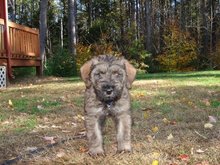
 Novice is the first level of the American Kennel Club's obedience trials. Three different judges must at least qualify a team with a score of 170 or higher in order for the participants to move onto the next levels, if they would like to. You can move onto open and utility trials after that. When people see these dogs in the ring, they think it's all about "pretty walking". It's actually about a lot more than that. Here are some dog training obedience exercises from the Novice trials, and their real life applications.
 Corrections are ways to improve communication in training and make corrections for training items that are either lacking precision and/or behavioral problems that need to be addressed. Corrections are not the same as punishment (either in the general public understanding which refers to a reaction after a negative event or the more scientific definition of punishment, meaning reducing behavior only or in other words does not mean physical harm in the scientific definition). For about the fist six months of a puppies life, training goes along usually with minimal corrections (like no, trading items, or redirection to something more appropriate) and punishment might be a simple crate time out. Hopefully you have been doing formal training during this point, which does have less expectation and precision than one would have of a more mature dog going through training.  For the purposes of this article, I am talking about fear (not fear [with] aggression, which has both positive and negative definitions in dog training, behaviors OR aggression behaviors). Nor the fear that a resource is going to be taken away, and not dominant behaviors (which in my definition are not necessarily undesirable). A dog's personality or temperament, IMO, can not be described as simply "fearful", "dominant", "abused", or "aggressive". Dogs have rich lives (or should have) just as we do, and are not put into one simple box definition. They may have behaviors that fit that definition (and will have other behaviors and characteristics beyond those), but dogs (themselves) can not be IMO defined this way.  I have had four Dobermans that came from a rescue shelter, Doberman Rescue Unlimited. Two of them were two years old when they came here, one of them was nine or ten years old, and one of them was weeks old, Boris. Our first dog, while not from a rescue, was a three year old female Doberman that we bought from a breeder, when we were checking out her puppies. Our first dog, Jazz, did not think my husband was the center of her universe at first (for a good three months or so while we figured it out). Our second dog, Neptune, had some handling issues that took some time figuring out. Our fourth dog, Jackie CD, did not bond with my husband for six months (he had been returned for this several times after not bonding quickly to other men). Our fifth and sixth Dobermans, Boris and Stormy, did happen to instantly feel at home. Whether it was Jazz, Neptune, or Jackie CD or the hundreds of dogs that come through from clients, my love for dogs has nothing to do with them instantly accepting me. Bottom line is that you are building a relationship and need to earn trust and respect. You can not expect it will be given to you instantly until you put time and effort into the relationship.
 I have loved animals since childhood. In my adult life, I enjoy my time spent with dogs. I love doing things with them that they love doing. My motivation comes from a place that wants to provide my dogs with the most enjoyment possible. I am the rare person that has not, in fact, met the dog she wouldn't like. Other dog trainers told me that when I worked enough dogs, I would find some that I did not like (dogs that is). This has not happened, though I will admit to liking some dogs less than others. This usually just has to do with more time spent with a dog/owner team over another. I like them all, and I appreciate them all. I like the ones who are bomb proof to the most behaviorally challenged dogs that I have had the pleasure of meeting.  The acquisition of an additional dog in the home can happen for a variety of reasons. The most common reason is the idea that the existing dog needs a canine companion. One human family member may want a companion that is more their special friend than another’s. An active family member may now need a younger dog to do certain activities with. A lot of good reasons exist for the introduction of a new canine member into one's home. Be aware though, this often comes with work to maintain a harmonious relationship between the two. |
Author, Robin RubinOwner and Head Dog Trainer in Maine, Robin Katherine Rubin, started her Maine dog training business in September 2004. Our dog training facility is located in Southern Maine in York Beach and we help families enjoy their dogs more, making sure they listen reliably and resolving unwanted behaviors. Archives
July 2024
Categories
All
|

 RSS Feed
RSS Feed